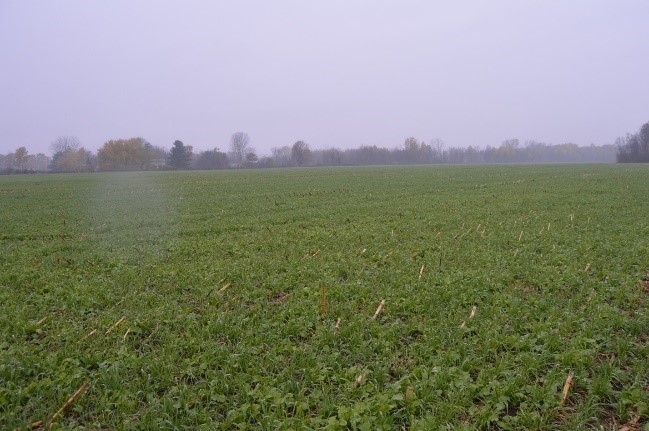By Kirsten Workman, UVM Extension
By now, you have heard of (and hopefully planted) cover crops as a strategy for protecting water quality and building soil health. Most cover croppers utilize winter cereal grains like winter rye planted after the main cash crop to cover the soil and protect it through winter and early spring. This is a fantastic strategy and one that fits into many situations.
Some folks have mastered the basics and are looking to more precisely target their cover cropping to meet their needs and maximize benefits. This is where alternative cover crop species and mixtures of species come into play. UVM Extension has investigated these cover crop combinations to figure out the best ways to fit these species into our local cropping systems.
Before you start down the cover crop cocktail path, however, you need to ask yourself three questions.
Why?
What are you hoping to accomplish with your cover crop? Are you looking for more or less spring residue? Maybe you have a weed problem you’d like to get under control or you’re looking for better carbon to nitrogen ratios to maximize fertility for the subsequent cash crop. Perhaps you want the transition to no-till to be a bit easier or (likely this year) you have a prevented planting that has left a field open unexpectedly. Whatever your reasons, it is important to identify what goals you are hoping to accomplish before selecting your cover crop species or mixture.
What?
Once you have identified why, you can decide which species to plant. Legumes like clover, peas, and vetch will bring nitrogen to the system and balance the carbon to nitrogen ratio when planted with cereal grains, reducing nitrogen immobilization in the spring. Brassicas are efficient manure utilizers and provide great fall soil coverage for erosion and weed control with their bigger leaves that tend to spread out instead of up. Their taproots provide deeper soil penetration, reducing compaction and bringing soil minerals from deeper in your soil profile up to the root zone. Annual ryegrass is an alternative to cereal grains and has a robust rooting system that holds soil and reduces nitrogen leaching. Fall planted forage oats can be a winter-kill alternative to winter cereal grains or planted with them to enhance fall cover, but diminish spring residue. The possibilities and combinations are endless. In general, a three way mix is a good place to start – one grain or grass, one legume, one brassica.
When?
All of these species require EARLIER planting dates than our winter cereal grains. This is the biggest consideration when selecting cover crop mixtures. Many of the legumes should be planted the first week of September. Brassicas, oats and annual ryegrass can go a bit longer, more like September 15th. This could mean interseeding, getting corn off sooner, or taking advantage of unique times in the crop rotation like after harvesting winter rye or before new seedings.
Prevented Planting could be an opportunity to really see these mixtures shine! I am always looking for the silver lining of all these rain clouds, and cover crop mixtures most definitely fit that bill. While nothing can really replace the lost forage from a missed corn silage crop or new seeding, it definitely creates an opportunity to maximize some alternative cover crops and set yourself up for success for next year.
There are always considerations, but some important ones are:
- Adjust your herbicide program accordingly when planting earlier and to avoid injury to more susceptible species like legumes/brassicas.
- Shorten your corn hybrid maturity (less than 2,000 GDD) to facilitate earlier cover crop planting dates
- Adjust nitrogen applications if you plant legumes – take credit for all that nitrogen!
- Start small before making a large investment in more expensive seed, and utilize a grain drill for better results and lower seeding rates.
- If you have an incentive payment contract, communicate with NRCS or VAAFM to ensure you are following their program requirements.
Have questions? Feel free to contact Kirsten by phone (802) 388-4969 x 347 or by email Kirsten.workman@uvm.edu
Cover Crop Resources:
https://www.uvm.edu/extension/agriculture/cover-crops-and-no-till
https://efotg.sc.egov.usda.gov/references/public/VT/VT340_Specs.pdf
 Caption: Forage Oats/Winter Wheat/Radish cover crop planted second week of September after timely corn silage harvest in Panton, Vt. (picture taken in late fall of the seeding year)
Caption: Forage Oats/Winter Wheat/Radish cover crop planted second week of September after timely corn silage harvest in Panton, Vt. (picture taken in late fall of the seeding year)

